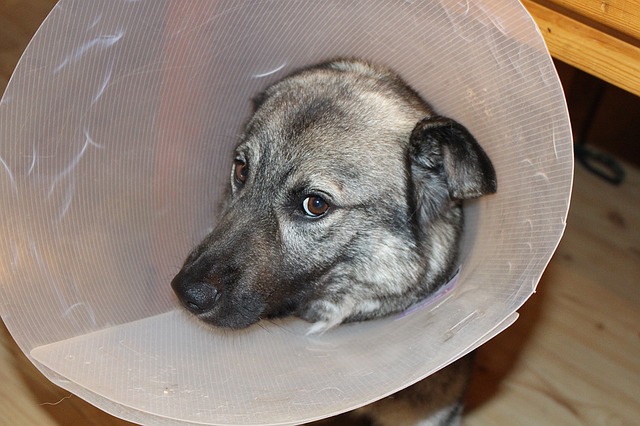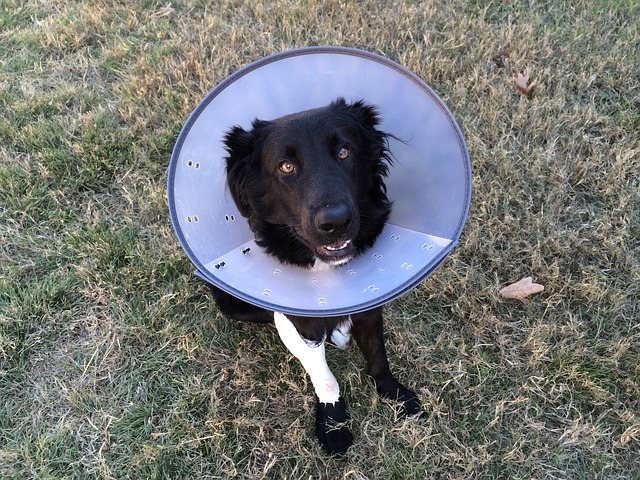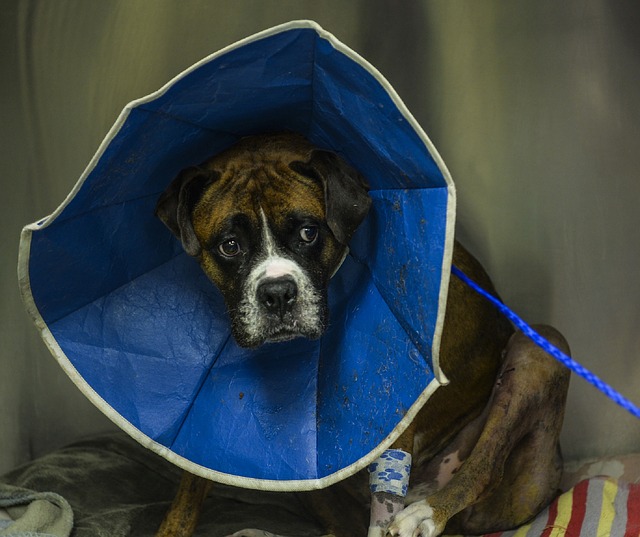Elizabethan collars (e-collars or cones) are often put around a dog’s neck to create a protective barrier between the head and mouth and the rest of his body.
The barrier is meant to prevent him from licking or biting his wound, lesion, or incision sites, promoting faster healing.
While it is necessary for dogs to wear Elizabethan cones after surgery, it can be annoying and stressful for some dogs as it limits them from doing certain things like cleaning themselves or fitting in gaps or smaller spaces that they normally do. As a result, some dogs tend to object to wearing it.
Some dogs use passive measures like hanging their heads down as if they are ashamed of the cone and some run around the house or yard smashing their heads on nearby objects.
Some may also irately try to remove the cone with their legs and others may jump around acrobatically in an attempt to get rid of the e-collar.
Some dogs may even pretend that they cannot eat or drink when wearing the cone.
Most dogs do all these theatrics to make you feel sorry for them or guilty for putting them in a cruel situation.
If you are not strong, you may give in to those puppy-dog eyes and remove the cone too soon.
This can be a big mistake considering that the cone can make all the difference in the recovery process.
So, How Long Should a Dog Wear Cone After Surgery?

The length of time a dog should wear his e-collar after surgery depends on the surgical procedure he had and his personal recovery time.
First thing first, it is important to note that when you remove the cone too soon, you will allow your dog to lick, scratch, and chew the incision site or wound, which could result in delayed recovery, prolonged treatment, and other health issues.
Even worse, stitches can be prematurely pulled out, causing more problems like failure of the incision closure (and possibly some organs popping out!) and infections.
So, the short answer to the above concern is: the cone should stay on the dog until the incision site is fully healed and the sutures removed.
Given that most surgical wounds take about two weeks to heal and the fact that most sutures and staples are often left in for about 10-14 days, most experts recommend leaving the cone on your dog for 10 to 14 days after surgery.
However, lesions may take less or more than 10-14 days to heal completely.
Generally, healing time often depends on the type of surgical procedure done, the suture material used, the suture absorption time, and other factors like your dog’s health and age.
For starters, surgical stitches tend to last long enough to promote complete healing of the affected tissues.
So, whether your canine friend received absorbable or non-absorbable stitches, the incision site needs enough time to heal.
Ideally, you should leave the e-collar on your dog until you visit your vet for a re-check appointment.
This is the time your vet will assess the stitches, the incision site, and the condition of your dog to figure out whether or not the cone should be removed.
Put simply, it is recommended for a dog to wear the e-collar after surgery until the stitches are removed.
If you have had surgery yourself, you probably understand that wounds can be very itchy when they begin to heal.
But if you don’t have time for a re-check appointment, you can ask your vet to give you an estimate for when it can be okay to remove the cone.
Know When to Temporarily Take Off the Cone

There are situations when you can temporarily take the cone off your dog.
For instance, you can remove the cone during meal times because as aforementioned, some pups may refuse to eat or drink with the cone on.
Besides, if the e-collar is obstructing your pup from essential functions, taking it off for a while is never a bad move.
However, you should do this sparingly and only under strict supervision. By strict supervision, we mean that you should be close enough to your dog to stop him from any undesired licking, scratching, rubbing, or biting.
Remember to put on the cone immediately your pup has finished eating, is done with the essential activity, or when you are not in direct supervision.
Additionally, if your dog appears to be in distress, consider taking the cone off for a while to check out what the problem could be.
If the current cone is big and stiff, for instance, consider switching to a softer fabric cone.
And if there is a need for your dog to wear a cone for longer than the mentioned10-14 days, you may consider getting him different types of cones for different occasions.
For instance, one cone may work better when you are close or supervising him, another when he is unattended, and another when he is sleeping.
With a bit of experimentation, you’ll find a cone that helps your pup heal in comfort.
Final Thoughts
Hopefully, now you know how long you should leave a cone on your dog after surgery.
Always remember that patience and love are essential elements if you want your canine friend to heal faster after surgery.
Your dog is already overwhelmed by the e-collar and it is your support and love that can change things a bit and make him feel better. So, always be as considerate as possible during this period!
If your pooch is having trouble with his normal activities like climbing stairs or getting out of a car with the cone on, for instance, lift him up and make his life stress-free.
If anything, your pup is only going to be in such a situation for about two weeks, so taking care of any problem that he has shouldn’t be a big deal.
In the end, your fur baby will be less stressed, more at peace, and experience a better recovery process.
It is also worth mentioning that there are alternatives to e-collars that can make the whole process easier for your pooch. Check out this post for ideas: 8 Best Dog Recovery Suits (Alternatives to E-collars)
We wish your pup a quick recovery!
Related Posts:
How to Make a Pool Noodle Dog Collar
How Long Does It Take For Dog Fur To Grow Back After Surgery?
As an Amazon Associate, we may receive a small commission from qualifying purchases but at no extra cost to you. Learn more. Amazon and the Amazon logo are trademarks of Amazon.com, Inc, or its affiliates.

